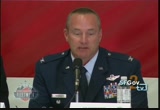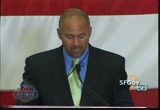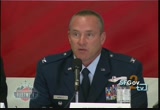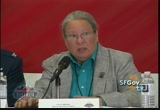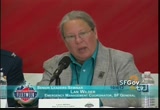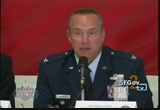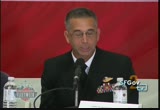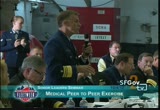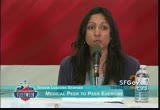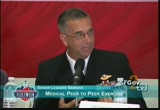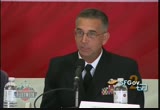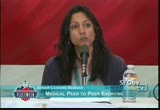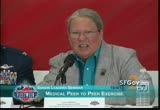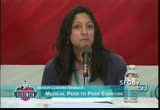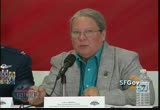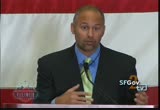tv [untitled] December 8, 2012 1:30am-2:00am PST
1:30 am
number of assets, the number of people trained to do these things are. the california national guard has air and land assets that are substantial and can be rapidly deployed to assist the civil responders in their mission to move people, to get things set up, to establish common security. it's a partnership that really needs to happen and is natural. the governor controls the california national guard, he can make forces appear very rapidly in support of a regional disaster, a local emergency or wherever they are needed, and transportation, communication, security logistics capabilities that come to the table really augment the medical care that's being provided in the disaster scene. >> like colonel ingels, i was impressed by the robust,
1:31 am
defined chain of command and a large response capable of being produced. however, in an overwhelming disaster things don't always go as planned and certainly our experiences in combat has showed us there and prior experience with disasters have outlined that even though there's a well-defined system of response it doesn't always work out. what i defined yesterday was that logistics problems may get in the way and interfere with medical surge planning as is outlined. putting resources where they are needed in a huge disaster may outstrip the ability of local authorities to do that because roads are out. the niche we have as the marine corps assets we have the ability to locate some of our resources like shock trauma
1:32 am
platoons, that's what we do in combat and we have experience with that and that may be something that may be of benefit to this process. >> during the last panel, mr. cahen mentioned it's so important to understand the resources that his agency has versus the ones that the military has and he said at one point they started looking down in terms of typing, i have this, you have this, how are we going to respond and get the resources we need to deal with the incident. i'd like to hear from all of you what did you learn about what the other agencies' capabilities are and how did that open your eyes? >> yesterday we had a great opportunity to look at a variety of resources. in the midst of all the demonstrations that we had, we actually had an hour lecture on dsca, which is pretty incredible to get everything about dsca in one hour. it was a great effort by the folks who do that lecture.
1:33 am
to show you how well i listened, i have some take away points on that. the first is that all disasters are local. the folks here in san francisco are going to be in charge from the minute the disaster happens and i think that that's really critical to understand. the local authorities evaluate the situation on the ground and execute what locally is available, then they evaluate shortfalls and what they have and then generate those requirements up through that defined chain of command, as i mentioned earlier. then once those agencies determine what those requirements are, they are given back to the city who employs those as they think they need to be deployed because, again, they are the eyes and understand the local situation. i think going through this that the navy and the marine corps, we're used to being in
1:34 am
charge whenever we show up and we're not going to be in this situation. i think it's important for us to understand that and we do and i think we, if we were employed in this certainly would understand that particular chain of command and would be able to fit right in and execute as required by the local situation. >> let me reiterate that the local authorities need to know that the emergency managers, the first responders, are there to be in charge to run things in their local disaster. everyone else that rolls in behind are there to enable them to do that, to manage to get back to normal so all the forces that roll in can finally leave. the emergency managers need to remain in control, they need to be situationally aware, they need to be in communicate with their forces, they need to understand what assets can become available as they need them. again, they are primed,
1:35 am
they have to be active and in place and everyone, everything everyone can provide to them, will help in their efforts to contain the disaster and get back to recovery. >> so one of the things that we learned yesterday is the military's very advanced in trauma care and blast injuries and other types of injuries that could happen in a large earthquake. in all planning we also have to consider other populations in san francisco and this was brought up in the hot wash yesterday. san francisco does have elderly populations, they have a lot of vulnerable populations, and we have to figure out if there can be integration with that as well. these are people we deal with on a daily basis and will have health issues in a disaster, especially if they can't get to their primary care doctors or get their education. another thing we took away was
1:36 am
a 88 team deployment and a lot of the assets come with teams and they integrate well and how we would get the local teams to integrate with the disaster teams is important as well. i'm glad to hear about the local command and control because i think that would be the expectation, is that we would be requesting these resources to integrate into our local response. >> i think the other thing we lerped is that regardless of the acronym soup that we all speak in, in all of this planning and preparation when it all comes down to it, we all speak medical. when it gets down to actual patient care, we will work together very, very well. we found out about capabilities that are quite flexibility we can use to integrate military and state and national guard capabilities and resources to decompress our
1:37 am
emergency departments if that's what the situation is; to offload hospitals that have had their infrastructure impacted that are no longer able to provide care, to provide critical care and just general medical surge for other types of injuries or chronic patients that can't get their needs met through any other means. so it's just a vast array of possible responses. the team i worked with and the other planners really got it when help arrives, they are going to be ready, willing and more than able to help us in the ways that we need. >> yesterday both the marine corps and the california air national guard brought some of their aviation assets and demonstrated those capabilities. miss wilder, earlier on you said game changing was a way to describe that. how do you feel being
1:38 am
more aware of those assets and what they can do will affect your planning? >> it really has changed. i can tell you on the bus coming back from the actual exercise event and the exchange event, there were so many discussions about what we can do differently and how we can change our plans so that there are more options, different ways we can look at which hospitals are still standing and what capabilities they have and then how to augment those and supplement with strategic use of state and dod resources. and really looking at how can we make the best possible care system stand and deliver after a catastrophic earthquake. and that was extraordinary. it was really, you know, it changed the perspective. if you understand most hospitals deal with short term emergencies, we have things that happen that are usually 4 to 12 hours in length for the most part except for h1n1,
1:39 am
which was so prolonged that it actually was a very different type of response for us. but all the other emergencies that we deal with are usually multi casualty incidents that are very short term in the initial sorting out and triage of those patients and getting them to definitive care. this type of situation requires us it think differently, very trat tee jikly, and plan our resource use and the evolving use of those resources, that it might be a big push for trauma care early on bringing in military assets to provide really strong triage, very clearly defined triage, of who needs what resources immediately and then using whatever we have at each of the hospitals and having that all staged so it's hopefully seamless for the patients that are coming to us needing care. >> doctor. >> i'm going to go back to my
1:40 am
earlier theme if we were isolated because the brinks were down, it's great to know that the military has so many assets that can come and help us. one of the things not everybody knows is we only have one heilpad and that's in the va luckily our new mission bay hospital has another one. we have identified sites but it's something to think through. when we are going through our planning and evacuation planning, especially, thinking of all the different sites where patients can be evacuated will be an important planning consideration. but i would like to echo lan's thoughts that this was all exciting to think about and it was received very well. >> anything else, dan? >> as we did on the last panel, that elevator speech, what did you share, what was your big take away that you gave to your boss to say this
1:41 am
was why this exercise was important and that take away. >> collaboration is key. jurisdictions need to work with one another, they need to understand who is in charge, what they've got, that goes from city to city, city to county, county to state, state to federal. everyone needs to be working together, understand who the partners are, what arrangement they are going to have for command and control, arrival of assets and things to deal with the local emergencies. things can go back in marin, california, lots of people are going to be rolling in. the time to form relationships and what one another can bring to the table is not when the disaster evolves but in anticipation of it. i think san francisco is doing a great job of getting all the partners together to understand more clearly what they can do with one another and what they can do to deal with an emergency and that just has to
1:42 am
happen again and again and again until we are on very good terms with one another from emergency providers, military providers, and what can be brought to bear to deal with a regional emergency. >> i think the real key thing for our take away is we need to do this again and we need to get closer together and do more hands on actual utilization of those assets and start simulating some of the types of things we're talking about doing. you learn so much more when you are actually practicing and working together. so just like the communications exercise, we need to make it more real and really stand side by side and see what kinds of things come up in that environment and how we can work out those gaps. >> yeah, i would agree. i think my take away would be that we should exercise together, small table tops initially and we can always
1:43 am
develop larger ones, to really understand the capabilities and further plan and also how integration would work during a big disaster. >> so first i would tell my boss, major general steve, sir, this was a very successful demonstration of our medical surge cape pblt and it was well done. but now we need to evolve and keep moving this forward. what we did on this particular time was stand-alone demonstrations of our particular capabilities. i think the next thing we need to do is a joint demonstration. for example, our shock trauma has many similarities to a dmat that might be a next step in the evolution of this type event. it also, after discussing with several members of the hospitals during the tour yesterday, it's clear that there are many other civilian military training opportunities
1:44 am
that exist. those can be maybe collaboration between medical personnel in military and civilian hospitals and many other options like that are possible. >> thank you. for our guests, what questions do you have? again, we have some microphones that can go around, we have two up front. >> very interesting. i have a question, both lewis and i were down at katrina right after it happened and one of the issues, you know, there were many medical issues. one was pharmaceuticals. did you discuss in this pharmaceuticals and how you would get your pharmaceuticals? >> we didn't specifically discuss it. we did i think in the shock trauma platoon know about what medications are carried on the c130, what medications were available. during the hhs presentation
1:45 am
there was talk about the large manufacturers, if there were problems getting medications, that the federal government could facilitate that. but it is a great point. it's something locally we are working on with our pharmaceutical group because it is a big concern if we do lose supply how do we replenish that. san francisco does not have a lot of storage space so we are not able to store medications to a great extent in the area. >> i was just going to echo, our capability does come with its own internal pharmaceutical supply, although it is limited and so that would be important for us to understand what the resupply process would be as we move forward on that. so we can certainly hit the ground running, but then we would need some sort shortly thereafter. >> mine is a two-part question. we've seen in ismat turkey in 1999 a number of walking wounded that will
1:46 am
immediately overwhelm the medical response community and then how do you disallow them immediate health care and the specter of reality tv, so that would be the first part, managing expectation in our gold standard health care system. the other part of that response, to maximize the saving of lives, they actually severed limbs in the response process to maximize the safing lives. have we talked about indemnify case of our medical response teams post response? ?oo ?a we did not actually discuss indemnify case or any other legal or even ethical issues on a broader kail. all the hospitals do have plans to handle a surge of patients including a very large number of walking wounded. we assume they will arrive at the hospital starting immediately, even sometimes before the
1:47 am
official announcement of a particular incident unless it's an earthquake where we feel the announcement of the incident. but the real key is that those plans will need to be immediately operational so that we can sort out who really does need to come in and get what level of care and that varies by facility, depending on their capabilities, along with hospital lockdown plans to secure the overall physical plant and make sure those capabilities remain intact for all sorts of threats. and the other key piece is dph is an immediate back up to that with the ability to use our clinics and our other partners to stand up potentially alternate care centers and other types of, depeplding on the situation, other types of areas where people can be triaged or get information or get care if necessary. so those plans are in place,
1:48 am
we're constantly developing them because we have to really look and we don't have the ability to predesignate every site, after an earthquake we need to make sure each and every site we announce to the public is safe before it's announced so it's a complex type of situation with constant situational awareness that has to be included. >> i just wanted to add on to that, that dph has a great resource of clinics. we are working with our clinics to take on those potentially minor trauma victims that they can treat and offload the hospitals. it would be a matter of triaging them at the hospital level and get them over there. >> just one other key point on that. we would also be working very closely with our partners in dem and the communications sector to really get the word out through our non-emergency informationalized public
1:49 am
messaging, whatever it takes to get the message out clearly, even if it's spray painted signage on the signs of buildings, we will get the word out where it is appropriate to go. >> we do have a very defined triage process that we've used in our, on our navy and marine corps side we're quite used to. it would be important to try, that's maybe another training thing we want to work on, that we collaborate and understand we're using the same system because we don't want to create two systems of triage within the city. that's a good way to create more chaos than there might ordinarily be. >> i'd like to follow-up on one of the things that was mentioned about the walking wounded. one of the things that came up after yesterday's after action group was this concept of different patient groups. in the military you have a fairly healthy soldier that you are going to be providing aid to. in san francisco we have young, we have old that have much more complex issues that you may
1:50 am
need to deal with. given your capabilities, how would you address that? >> it's a significant concern although it may be a little bit artificial in that we do, our doctors and surgeons and nurses do take care of a wide number of population groups outside of active duty military either at their mtf's or in other previous medical care and disasters we have a experience with a wide range of third world countries and so on. we need to be sensitive on that but i don't believe there's a big training gap that exists in that setting. >> one of the other things that we're doing is also learning from our military partners. the event continues this afternoon with another part of the medical exchange where military subject matter experts are going to be presenting basically a grand rounds of what is new in trauma
1:51 am
care from battlefield experience and bringing that to the civilian medical personnel, which this alone is an extraordinary opportunity and what we can do to capitalize on so many of the innovations that have been made in medical care have come from the military and we need to take that and learn from it and see what we can do to improve care over all. >> other questions from our guests? >> i just had a question, as you are moving patients from -- they are entering the facility, they are entering the system and then they start getting handed out and eventually, i suppose, evacuated, did you guys talk about patient records and how you are tracking these patients? >> we did touch on it a bit during the exchange we had at noon. the national system is run through jtap which is a
1:52 am
fantastic system and we've seen it in a few of the exercises around. right now the region is doing a feasibility study if jtap would be feasible for us to use and if it is, it would be fantastic. our concern is if it's only used during a sdas ster and it's not used on a daily basis, are you going to have to spend a lot of time training? it's not really hard to use but there are some complexities with it. so it is a big job in the city tracking patient movement and we are addressing it. and i think we're waiting for the feasibility study to kind of determine what our next step would be. >> i think there was another question here. yes. >> yes, we know from hsda studies that for a very large earthquake you can expect perhaps tens of thousands of
1:53 am
individuals that will need hospital treatment and hospitals are generally fairly full anyway. was there any discussion of altered standards of care during your workshops? >> not during the workshop specifically but it is something we've discussed at our hospital council group on and off and it is something the counseling association of hospitals is working on as well. i think we have to think as a group locally what type of policy we would want to have. i don't know that we'd have an alternate standard but we might have a policy if there was a huge medical surge event what kind of standards we would be willing to accept and that would be working on in conjunction with all of our partners. >> that's probably one of the most difficult and controversial subjects in disaster medical response right now because it can be so
1:54 am
difficultment until you are there in the situation and know exactly what resources you have and what your capabilities are day by day it really will change so much. so that's why bringing in partners early to offload and shift where we can provide care will make a huge difference. we don't ever want to see providers making the kind of decisions that had to be made during katrina and other events. instead of having a set standard of care, even if it's an altered or austere standard of care, what we want to have is good decision framework. until you are in the situation you can't determine what you would actually be doing and what resources are still available. >> do we have other questions from our audience? one final question and this is for our civilians. you got to see all
1:55 am
kinds of cool stuff yesterday down at moffat's field. i want to see if there's one or two that stuck out. >> i think the c130 definitely blew me away, the fact it can transport 92 people, patients, was incredible. the other 1 that stands out is the mobile decon patient, that it can decontaminate a patient that was not able to stand. >> the team from the hospital that i was with and the other hospitals really looked at what were their hands on capabilities and some of the things that stood out the most is a portable oxygen generator that sits in the corner of the shock trauma platoon unit and doesn't have to be hooked up to our large liquid oxygen tanks and all that piping that might get disrupted during a major
1:56 am
seismic event. having something just that simple could make a huge difference. maybe we were thinking small but just really direct hablds on patient care, there was a portable iv pump and fluid warmer that literally would fit in your hand and is battery powered. anything that's portable and is battery powered will make a huge difference in the type of disasters we're facing. we can leave it with the patient, move it with the patient, i know they have a whole list of other things they want and we have to take a lack at that and see what we can actually do. >> i do have one question and it deals with licensing. we're going to have physicians performing medical operations and they aren't licensed in the state, does that present any kind of issue for the emergency response?
1:57 am
>> so the state of california has the disaster health volunteer system. and you can sign up on there and they will look at the credentials within 24 hours and say if -- that's the extent, though, they don't do any background checks. so the locals have to kind of develop their own policies and again that is something we're working on. we have a lot of great doctors and nurses in san francisco and knowing they would be willing to respond in case of a disaster is important. capturing that information on dhv and know they would be able to go to other facilities if need be is one of our big to do items. >> each hospital is also required to have a whole plan for credentialing volunteer medical professionals, both those who are licensed independent practitioners and those who have either
1:58 am
certifications or other non-licensed kind of health care practitioners and a whole way to integrate them into their response if necessary. it's part of the joint commission standards for hospitals in planning for emergency response as well. >> the military has no problem, then, your shock trauma platoon comes in and you have medical personnel, i guess i was aiming at the military side. if we have (inaudible) does that apply to the military. >> many of them who serve in california are not licensed in california, the military has a waiver for that requirement. so i'm not certain how that would apply if we're using those folks in a humanitarian disaster in california. we're able to treat our folks regardless of the state of licensing in a particular
1:59 am
state, though. >> last year when i took a look at the shock trauma platoon, and i'm going to talk to you about that one really cool thing i saw. i have a little bit of medical experience and to see they have effectively a robotic soldier that can go into defib, whose eyes can dilate, they can do pulses both radial and distal and there is a programmer who is effectively testing a battlefield soldier what to do, i found absolutely fascinating as a way to bring a real life experience to that individual. for me that was a fantastic tool that you have and i thought that was wonderful. >> we're going to be -- little advertisement -- we're going to be demonstrating that capability at our display at the marina green so if you'd like to come see that, that's available. >>
57 Views
IN COLLECTIONS
SFGTV2: San Francisco Government Television Television Archive
Television Archive  Television Archive News Search Service
Television Archive News Search Service 
Uploaded by TV Archive on

 Live Music Archive
Live Music Archive Librivox Free Audio
Librivox Free Audio Metropolitan Museum
Metropolitan Museum Cleveland Museum of Art
Cleveland Museum of Art Internet Arcade
Internet Arcade Console Living Room
Console Living Room Books to Borrow
Books to Borrow Open Library
Open Library TV News
TV News Understanding 9/11
Understanding 9/11